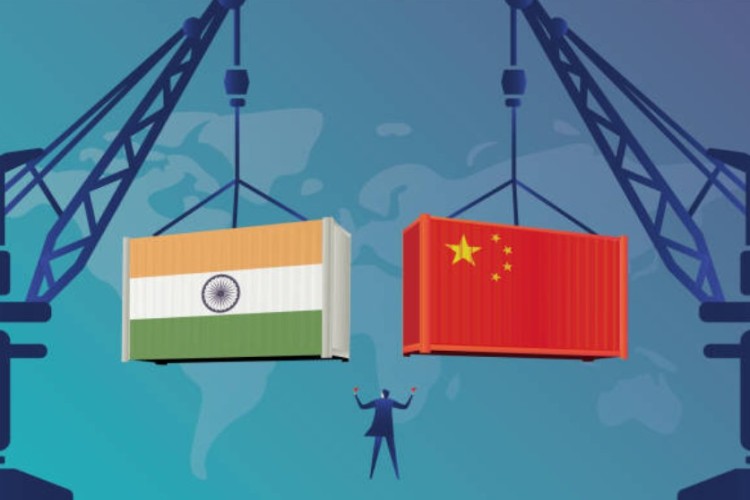Inside India-China trade shift: India’s brief flirtation with a reset in ties with China has ended before it took off. After months of speculation about a thaw, New Delhi is quietly reconsidering its trade posture. Rising dependence on Chinese raw materials has forced a rethink on tariffs and import curbs that were once symbols of Atmanirbhar Bharat. The dilemma is stark: how far can India protect its domestic industries without cutting itself off from the global supply chains that power its growth?
For policymakers, this is an uneasy balancing act. India must manage trade relations with both Washington and Beijing. Earlier this year, China slowed supplies of key goods such as fertilisers, disrupting India’s imports. A policy shift toward better relations with Beijing was expected, but little changed on the ground.
READ | Services exports surge masks India’s jobs deficit
Now, subtle adjustments IN India-China trade policy are taking shape. Anti-dumping duties are quietly being allowed to lapse, and tariffs on raw materials for sectors such as leather and engineering are being cut. This marks a shift in the tension between Aatmanirbhar Bharat and global integration — a move from isolationist protection to pragmatic openness.
From self-reliance to strategic flexibility
The push for self-reliance since the 2020 border clash and the pandemic had clear objectives — reduce strategic vulnerability and strengthen domestic manufacturing. The government imposed import restrictions, launched anti-dumping probes, and encouraged local sourcing to reduce dependence on Chinese inputs and technology. The aim was to protect India’s geopolitical leverage and prevent supply chain shocks.
The India-China trade numbers tell a different story. India’s manufacturing remains heavily dependent on Chinese supplies. Imports from China rose over 16% to exceed $11 billion in September, touching $91 billion in the first nine months of 2025, up from about $80 billion a year earlier. These figures highlight the gap between aspiration and industrial reality.
India-China trade and competitiveness
Ironically, policies designed to protect Indian industry are beginning to erode its competitiveness. High tariffs on raw materials have raised costs, forcing domestic manufacturers to pay more than their global peers. Industry associations have voiced concern that import restrictions are curbing efficiency and slowing export growth.
In response, the commerce ministry and NITI Aayog have backed a more flexible approach — cutting duties on critical inputs where domestic capacity remains weak. This pragmatic recalibration acknowledges that India’s earlier protectionist stance was hurting industry rather than helping it.
The realist turn in trade policy
This course correction in India-China trade policy is not a surrender; it is realism. Atmanirbhar Bharat was never meant to imply economic isolation. It means building domestic capacity while remaining part of global supply chains. In today’s interdependent world, competitiveness depends on access to international flows of raw materials, components, and technology.
Sectors like pharmaceuticals, electronics, and chemicals depend on imports of key ingredients and sub-assemblies. Cutting off these lifelines risks making India’s industries less productive and globally uncompetitive.
The case for smart openness
Protection and openness each come with costs. Import substitution and high tariffs safeguard local jobs but inflate input costs and delay technology transfer. Greater integration, on the other hand, lowers costs and opens export opportunities — but also deepens exposure to strategic risk, as seen in dependence on Chinese APIs and electronic components.
The emerging consensus is for smart openness. India is retaining trade-remedy tools such as new anti-dumping probes on cranes, solar cells, and toner cartridges. It is also reducing tariffs where domestic industries cannot yet compete. This blend of select protection and targeted liberalisation is the middle ground India needs.
Building a competitive node in global manufacturing
The new self-reliance model must go beyond the “make everything in India” slogan. It should focus on making India a competitive node in global manufacturing — producing more at home while importing efficiently where necessary. Lower tariffs are useful only if firms absorb the benefits, upgrade technologically, and become globally competitive.
However, policymakers must ensure that cheaper imports do not weaken domestic capacity. The lesson from earlier Chinese inflows is clear: openness without industrial capability leads to dependency, not competitiveness.
China remains a vital link in global supply chains, but over-dependence is risky. India must diversify its supplier base, especially for strategic goods. As the world fragments into competing trade blocs, India’s challenge is to stay open, yet self-reliant; integrated, yet independent.
In short, openness in India-China trade must not become passivity. India’s new trade realism should balance strategic autonomy with global competitiveness — a fine line between protection and participation that will define its economic future.

